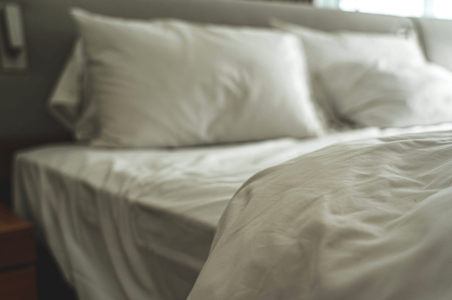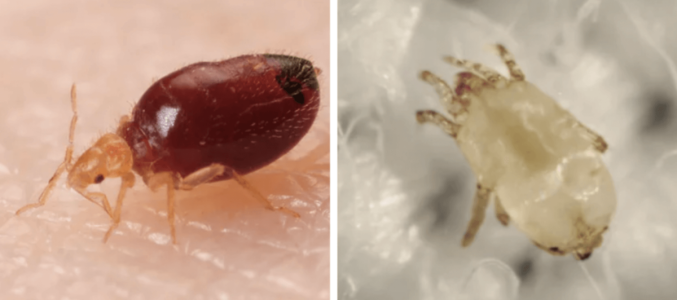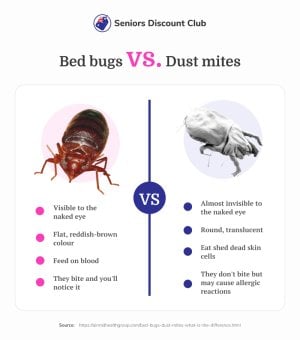Why Making Your Bed Should Be the Last Thing on Your Morning To-Do List
- Replies 10
Raise your hand if you're a fan of starting your day with a warm cuppa and a little peace and quiet. We hear you, and we understand. That's why we were as shocked as you might be to hear about this recent discovery from a cleaning expert.
Here at the SDC, we're all about that morning routine life. But according to the anonymous cleaning pro behind Mrs D's Cleaning Reviews, it might be time to say goodbye to one of our favourite habits: making the bed.
Why, you ask? Turns out that aside from sweating, we're all 'shedding skin' while we sleep, and that makes our beds the perfect breeding ground for nasty critters. And if you're a bed-making fanatic, you might be making the problem even worse by trapping damp air underneath your covers.
Gross, right? We agree. The thought of sleeping on a bed full of bugs is enough to give anyone the creeps.

So what should we do with our bed after we wake up?
The cleaning expert had just the solution: your best option would be to 'let your bed breathe' by letting your bed air out for as long as possible before pulling the covers back up.
So, if you don't want to be susceptible to health problems triggered by things like dust mites (such as allergies and asthma), you better forgo making the bed!
Mrs D recommends leaving bedding to air for 'at least an hour' each day. But for those of you who don't have that long before going to work, simply leave it unmade all day and fix it when you get home. The more time, the better!
The best part is, this goes for all year round, not just summer. With the rise of central heating, dust mites can breed just as much during winter as in summer.
If you've ever woken up itching and congested, even after a full night's sleep, dust mites and bed bugs could be lurking in your bed. Here are some simple steps you can follow to get rid of them:

Wash your sheets
Give your bedding a deep clean by washing your sheets, pillowcases, and comforters in hot water. This will kill any dust mites and bed bugs that might be hiding in your bedding. Don't forget to dry everything on high heat for at least 30 minutes to ensure the bugs are gone for good.
Vacuum your bed
Vacuum your mattress and bed frame to remove dust mites and their eggs. Make sure to get into all the seams, crevices, and folds, as these are the favourite hiding spots for these pests. And when you're done, be sure to dispose of the vacuum bag immediately to prevent any escapees.
Invest in a mattress cover
Put a barrier between you and the pests by encasing your mattress and box spring in dust-proof, bed bug-proof covers. This will prevent bed bugs from sneaking in and out, and will also keep dust mites trapped inside.
Stay vigilant
Regular inspections are key in keeping your bed bug-free. Check your bed regularly for bed bugs and their signs, such as tiny black spots or rusty streaks on your mattress or sheets.

Bed bugs and dust mites are two different types of insects that are often mistaken for one another due to their small size and similar habitats. However, there are several key differences between the two:

1. Size
Bed bugs are about the size of an apple seed and are visible to the naked eye, while dust mites are much smaller and not visible without magnification.
2. Appearance
Bed bugs have a reddish-brown colour and are flat, while dust mites are translucent and have a rounder appearance.
3. Habitat
Bed bugs prefer to live in close proximity to their food source, which is human blood and can often be found in bedding, furniture, and clothing. Dust mites, on the other hand, feed on dead skin cells and are found in dust and other organic materials throughout a home, including bedding, carpets, and upholstered furniture.
4. Biting
Bed bugs bite humans and other warm-blooded animals to feed on their blood, while dust mites do not bite.
5. Allergies
Dust mites can cause allergies in some people, leading to symptoms such as sneezing, runny nose, and itchy eyes, while bed bugs do not cause allergies.
In summary, while both bed bugs and dust mites can be nuisance pests, they have distinct differences in terms of their appearance, habitat, biting behaviour, and potential health effects.
Members, have you ever been kept up at night by the thought of dust mites, bed bugs, or other unwanted critters crawling in your bed? We've all been there, and it's not a pleasant experience.
What do you do to keep your bedding clean and fresh? Do you have any secret tips or tricks to share with the community? We want to hear from you! Leave us a comment below with your best bedding hacks.
Here at the SDC, we're all about that morning routine life. But according to the anonymous cleaning pro behind Mrs D's Cleaning Reviews, it might be time to say goodbye to one of our favourite habits: making the bed.
Why, you ask? Turns out that aside from sweating, we're all 'shedding skin' while we sleep, and that makes our beds the perfect breeding ground for nasty critters. And if you're a bed-making fanatic, you might be making the problem even worse by trapping damp air underneath your covers.
Gross, right? We agree. The thought of sleeping on a bed full of bugs is enough to give anyone the creeps.

One of the most common bed-making habits that we embrace each morning might be doing us more harm than good. Credit: SHVETS production.
So what should we do with our bed after we wake up?
The cleaning expert had just the solution: your best option would be to 'let your bed breathe' by letting your bed air out for as long as possible before pulling the covers back up.
So, if you don't want to be susceptible to health problems triggered by things like dust mites (such as allergies and asthma), you better forgo making the bed!
Mrs D recommends leaving bedding to air for 'at least an hour' each day. But for those of you who don't have that long before going to work, simply leave it unmade all day and fix it when you get home. The more time, the better!
The best part is, this goes for all year round, not just summer. With the rise of central heating, dust mites can breed just as much during winter as in summer.
If you've ever woken up itching and congested, even after a full night's sleep, dust mites and bed bugs could be lurking in your bed. Here are some simple steps you can follow to get rid of them:

Leave your bed unmade for at least an hour every day to allow for air circulation, or throughout the day if you can't spare the time in the morning. Credit: Pexels/Castorly Stock.
Wash your sheets
Give your bedding a deep clean by washing your sheets, pillowcases, and comforters in hot water. This will kill any dust mites and bed bugs that might be hiding in your bedding. Don't forget to dry everything on high heat for at least 30 minutes to ensure the bugs are gone for good.
Vacuum your bed
Vacuum your mattress and bed frame to remove dust mites and their eggs. Make sure to get into all the seams, crevices, and folds, as these are the favourite hiding spots for these pests. And when you're done, be sure to dispose of the vacuum bag immediately to prevent any escapees.
Invest in a mattress cover
Put a barrier between you and the pests by encasing your mattress and box spring in dust-proof, bed bug-proof covers. This will prevent bed bugs from sneaking in and out, and will also keep dust mites trapped inside.
Stay vigilant
Regular inspections are key in keeping your bed bug-free. Check your bed regularly for bed bugs and their signs, such as tiny black spots or rusty streaks on your mattress or sheets.
Key Takeaways
- Making your bed first thing in the morning may actually be unhealthy due to dust mites and bedbugs potentially being trapped underneath the covers.
- Dust mites and bed bugs like to live in places that are warm and damp, and your bed is the perfect place for them to thrive.
- It is recommended to air out the bed sheets and covers for at least an hour a day before covering them up again.

Due to their similar size and living conditions, bed bugs and dust mites are frequently confused with one another. Credit: YouTube/Deep Look.
1. Size
Bed bugs are about the size of an apple seed and are visible to the naked eye, while dust mites are much smaller and not visible without magnification.
2. Appearance
Bed bugs have a reddish-brown colour and are flat, while dust mites are translucent and have a rounder appearance.
3. Habitat
Bed bugs prefer to live in close proximity to their food source, which is human blood and can often be found in bedding, furniture, and clothing. Dust mites, on the other hand, feed on dead skin cells and are found in dust and other organic materials throughout a home, including bedding, carpets, and upholstered furniture.
4. Biting
Bed bugs bite humans and other warm-blooded animals to feed on their blood, while dust mites do not bite.
5. Allergies
Dust mites can cause allergies in some people, leading to symptoms such as sneezing, runny nose, and itchy eyes, while bed bugs do not cause allergies.
In summary, while both bed bugs and dust mites can be nuisance pests, they have distinct differences in terms of their appearance, habitat, biting behaviour, and potential health effects.
Members, have you ever been kept up at night by the thought of dust mites, bed bugs, or other unwanted critters crawling in your bed? We've all been there, and it's not a pleasant experience.
What do you do to keep your bedding clean and fresh? Do you have any secret tips or tricks to share with the community? We want to hear from you! Leave us a comment below with your best bedding hacks.








